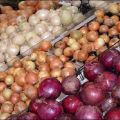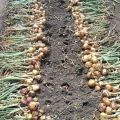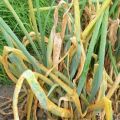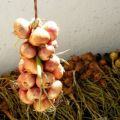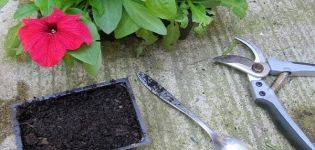How to plant onions correctly in spring or autumn so that there are large bulbs
Onions are a vegetable crop grown by almost every gardener. This is because bulbs are one of the most popular cooking ingredients and a healthy addition to the diet. That is why many summer residents are wondering: how to plant onions correctly so that there are large bulbs? To get a good harvest, onion planting should be carried out taking into account several rules: choosing a place, selecting planting material, determining the optimal season.
Preparing the soil for spring planting
Before you start planting a plant culture, you need to understand what kind of soil the onion loves. The first step is to understand that the onion culture is actively growing and developing in good light and warm conditions.
If the plant experiences a lack of light, the bulbs will not develop, and the planting will soon fade. Therefore, the best option for growing onions are central places in the garden, next to which trees do not grow, tall buildings are not located.
Then it is required to determine the type of soil, the earth is diagnosed using a litmus test. Onion loves sandy or sandy soil... In such conditions, the plant forms a healthy, powerful root system, and also ripens in a timely manner.
Next, you need to know how to prepare a bed for onions, the preparatory measures are as follows:
- In the autumn, the bed is fertilized with rotted manure or ash. These fertilizers contain a large amount of nutrients that help the onions develop. The optimal amount of fertilizer per 1 square meter: 6 kilograms.
- The entire ridge needs to be dug to a depth of 20 centimeters.
- All debris and weeds are removed from the soil.
- After the soil is fertilized, it must be leveled with a rake and left in this state until the onset of spring.

This soil preparation will allow you to get a healthy, large yield of onions. In the spring, you need to re-dig the soil. This will distribute nutrients evenly in the ground.
Preparation of planting material
To get a good harvest, it is necessary to process the onions before planting. First of all, the bulbs are moved. For planting, only healthy bulbs can be used, on the surface of which there is no damage.
Further, the preparation of planting material must be carried out using the instructions:
- The selected set is sorted by size. This is necessary for the onion to grow evenly.
- The planting material is left to dry at a temperature of 35 degrees for 3 days. If it is not possible to dry the onion in this way, it must be calcined in the oven at a temperature of 40 degrees. The cooking time in the oven is 4 hours.
- Then the sevok is immersed in the ost stimulator for 8 hours.
- The bulbs are removed from the fertilizer and immersed in a weak solution of potassium permanganate for 10 minutes.
- Then the planting material is rinsed and used for planting.
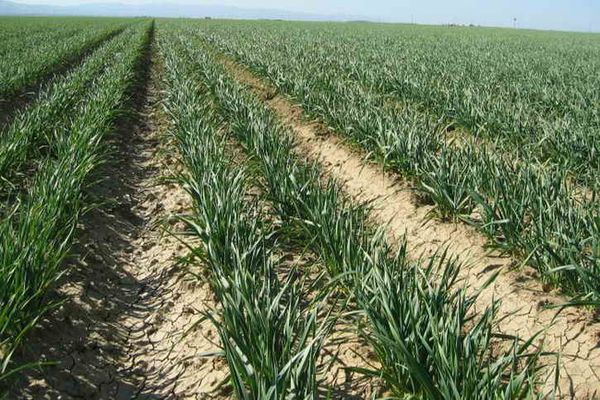
Such processing and soaking of onions before planting activates metabolic processes in the bulbs, improves their germination, and protects against diseases.
How to properly plant onions on a turnip?
To get a healthy plant, a developed turnip, we plant the seedlings in the ground only when it warms up to 12 degrees. In most cases, in spring, onions are planted on turnips in mid-April or in early May. Planting is best done in cloudy weather conditions, while it should be dry outside. Then holes are made in the garden according to the following principle:
- there should be a distance of at least 15 centimeters between plants in a row;
- the distance between the rows should be 30 centimeters;
- seedlings should be deepened into holes or grooves by 7-10 centimeters.
After planting the seedlings, the soil should be watered. To do this, you need to use settled water. It is desirable that it be at room temperature.
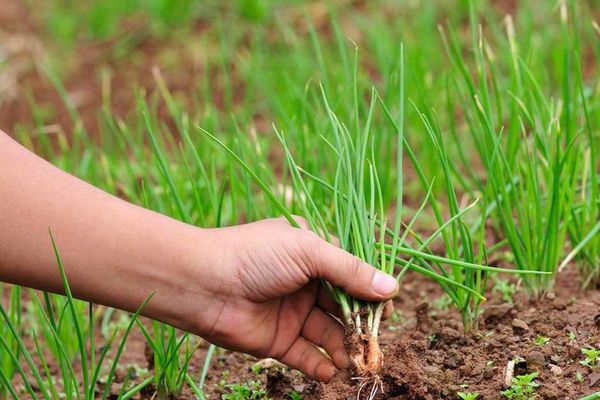
If, during planting, the summer resident made a mistake and placed the bulbs close, they need to be thinned out. Otherwise, during the growing season, crops will be deficient in nutrients. In this case, the growth of the bulbs will stop, and the root system will begin to intertwine. It will be difficult to thin out the plants during this period.
Planting onions in July or spring
If the summer resident decided to plant a plant in July or spring, he needs to prepare the onion beds in the fall. There are several differences between growing a crop in spring or summer.
If the summer resident wants to grow onions from seed, sowing should be organized immediately after the soil warms up and the snow melts. Only with such a planting will the onion have time to ripen. If the gardener has seedlings that were sown in the last days of February, they need to be transplanted into the ground in mid-April. If the summer resident wants to plant a turnip in the spring, you will need the recommendations indicated above. In this case, sevok is used as planting material.
Many summer residents, in order to get a richer harvest, plant seedlings twice. It should be noted that only in a southern climate is it possible to grow onions in July. The July planting can only be carried out if the summer season ends in mid or late September.
Having planted onions in the summer, it is necessary to harvest at the end of August, so only early ripening varieties of crops should be used for planting. A July vegetable is planted in a similar way.
Sowing with seeds
In most cases, a turnip vegetable is grown in 2 years. Such cultivation is typical for sowing a plant with seeds. From the sown seeds of nigella, onion sets grow, which the next year is used to grow turnip. The temperature and scheme of planting, sowing seeds is determined using the following instructions:
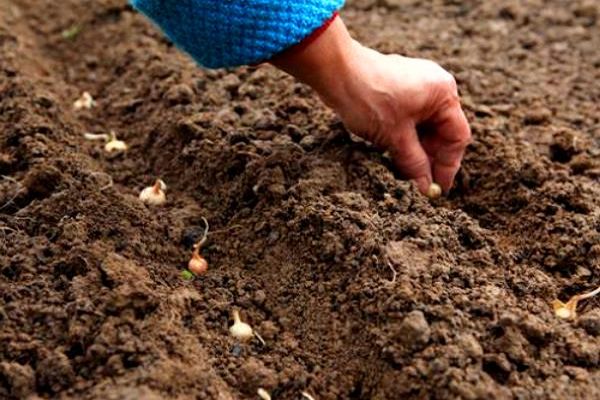
- First, the seeds are soaked in warm water. This procedure is necessary in order to select healthy seeds, discard empty ones.
- After 24 hours, the water is drained. Only the seed that has fallen to the bottom is taken from the bowl.
- Selected seeds are placed in cheesecloth, wrapped and placed in a darkened place.
- After the seeds are dry, they are treated with a solution of potassium permanganate.
- After disinfection, the material is dried and used for sowing.
Preparing the soil for sowing is carried out according to the instructions above. Then the summer resident can start sowing:
- in open ground conditions, grooves are made, the depth of which is 2–4 centimeters;
- a distance of 10-30 centimeters is made between the rows.
- grooves are watered with hot water to disinfect the soil;
- seeds are sown at a distance of 1-3 centimeters from each other;
- then the beds are re-irrigated using water at room temperature;
- the beds are covered with foil.
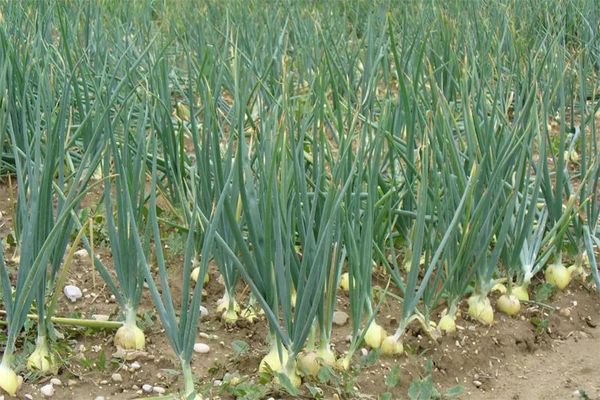
After shoots appear on the soil surface, the film can be removed.
How to plant winter onions?
For planting before winter, you must use a small size set. It is necessary to plant the planting material grown in spring 3-4 weeks before the soil freezes. It is better to plant onions when the ambient temperature drops to 5 degrees.
Planting a winter variety is carried out taking into account the instructions:
- Furrows with a depth of 3-4 centimeters are formed on the ridge.
- Furrows are located at a distance of 10-15 centimeters from each other.
- Sevok is planted in furrows at a distance of 3–10 centimeters from each other. The distance is determined by the estimated dimensions of the turnip: the more the variety forms the turnip, the longer the distance between the sets should be.
- Furrows are covered with earth, covered with mulch. Dry leaves, humus, spruce branches, tops, sawdust, pine needles are used as mulch.
After the onset of spring, the snow melts, it is necessary to remove the mulch. This will allow the soil to warm up faster. Then the earth is loosened, the plants are fed with chicken droppings diluted in water. When leaves appear, you need to add a second dressing. The best option for this is the drug Plantafol.
Harvesting onions begins when the leaves fall on the ground and the scales of the bulb acquire the color characteristic of the variety. The onions are dug out very carefully and left to dry in a ventilated area. After the bulbs are dry, they can be stored.
Outdoor onion care
During the cultivation of the plant, it is necessary not only to process the onion before planting, but also to provide other necessary care. To get a good harvest of onions, you must follow a few simple rules:
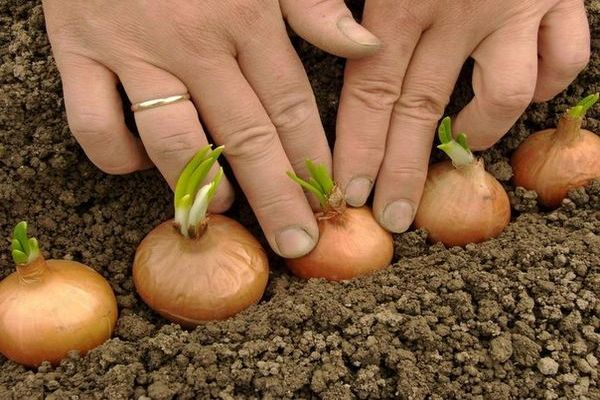
- watering plantings is required once a week;
- only settled water should be used for irrigation;
- in dry weather, watering is carried out twice a week;
- after watering or rain, the soil must be carefully loosened;
- all weeds that appear must be removed in a timely manner;
- as a means for the prevention of fungal and viral diseases of onions, copper sulfate can be used;
- in July, the number of waterings must be reduced in order for the turnips to fully mature.
After the first shoots appear, the plants should be thinned if necessary.
Chinese way of growing bulbs
In addition to the traditional cultivation method, there is also a Chinese one. Growing large onions from planting material was invented by the Chinese by forming ridges, not ridges. The ridges are formed so that they rise 15–20 centimeters above the ground, with a distance of at least 30 centimeters between them. Instructions for planting onions in the Chinese way:
- The prepared seedlings are immersed in the ridges 2-3 centimeters deep, covered with earth, and compacted a little.
- The comb is poured with water.
- Then the soil is loosened.
It is best to plant onions in the Chinese way early in the morning to protect them from the sun's rays. This planting method allows you to grow a rich harvest of large, fully ripe and fully formed bulbs.


